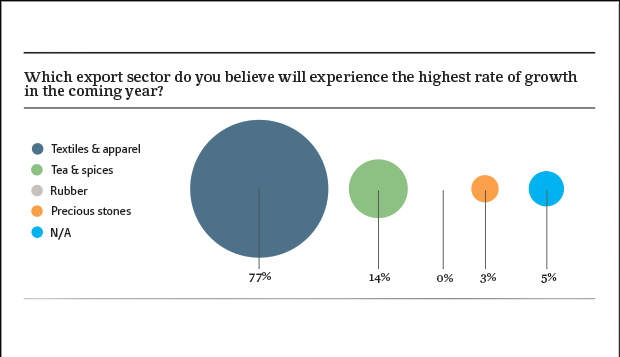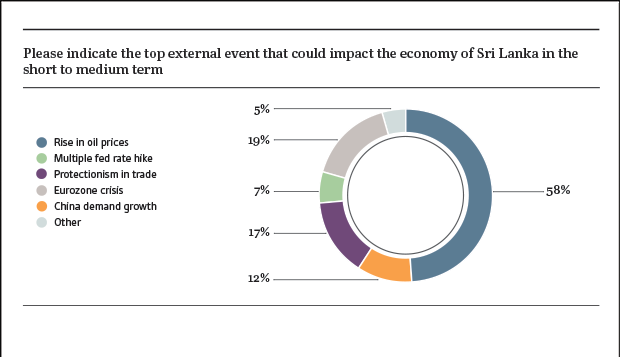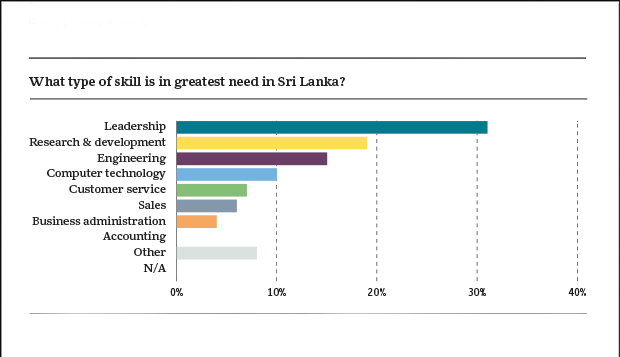CEOs Tip Textiles to Lead Sri Lanka’s Export Revival in 2018
26 Feb 2018
As Sri Lanka sharpens its focus on achieving $20bn in export earnings by 2020, executives interviewed for OBG’s most recent Business Barometer: Sri Lanka CEO Survey have resoundingly voted for textiles and apparel as the export segment likely to experience the highest rate of growth in overseas shipments in 2018.
Some 77% of CEOs who took part in our face-to-face survey predicted that the garments industry would be the growth engine for exports in the year ahead, followed by tea and spices at a distant second with 14%.

Textiles and tea are the backbone of Sri Lanka’s tradeable sector, respectively comprising 47% and 12% of total exports in 2016. Under President Maithripala Sirisena’s National Export Strategy, ICT, wellness tourism, spice concentrates, boat building, processed food and beverages, and electronics/machinery were identified as the six priority areas for diversifying the country’s export base. While diversification will certainly contribute to meeting the government’s bold targets, it is clear that local business leaders expect traditional industries to underpin growth for the foreseeable future.
Export industries received a welcome boost in May 2017, when the EU reinstated Sri Lanka’s Generalised Scheme of Preferences Plus (GSP+) status, which had previously been rescinded over human rights concerns in 2010. GSP+ status removes the majority of import duties on Sri Lankan goods entering the European single market, and likely drove the 13.8% year-on-year increase in garment exports to the EU in November 2017.
Even though the immediate future looks bright for the garments segment, Sri Lanka would be wise to devise adaptation strategies for technological advancements in manufacturing processes. Developments in innovative areas such as 3D printing and robotics are likely to erode some of the country’s current competitive advantages in the years to come, as without the need for lower labour costs, clothing giants may start to move production facilities closer to their main consumer markets.
Oil price rise worries executives
One of the chief reasons for Sri Lanka submitting to the $1.5bn IMF bailout package was the profligacy of the previous Mahinda Rajapaksa administration, which had agreed to a number of high interest Chinese loans to fund infrastructure projects. Many of these developments have operated below capacity since completion, making it difficult for Sri Lanka to honour its payment commitments. As a result, the Sirisena administration has been forced to make hard choices, such as handing over control of 70% of Hambantota Port to Chinese interests on a 99-year lease.
Chinese investment plays a major role across Sri Lanka’s economic sectors: China is now the country’s main source of foreign direct investment, its largest trading partner and its second-largest tourism source market. Despite this, just 16% of executives surveyed in our barometer cited a slowdown in Chinese demand as the top external risk that could impact the national economy in 2018.
This was dwarfed by concern over rising oil prices, with 49% of respondents placing this as the top risk factor, an understandable opinion given that Sri Lanka was forced to ramp up oil imports last year, following a severe drought that hampered hydro-generation capacity.

Storm clouds are clearing
Following the severe floods and drought that weighed on growth in 2017, C-suite executives appear to be generally optimistic that clearer skies are ahead, with almost three-quarters saying they were positive or very positive about local business conditions in the coming 12 months.
Additionally, 56% predicted GDP expansion to range 4-5% for 2018, which is broadly in line with the Central Bank of Sri Lanka’s prediction of 5-5.5% and the Asian Development Bank’s forecast of 5%.

Not only that, but our respondents seem prepared to put their money where their mouth is: almost 75% said their firms were likely to make a significant capital investment in 2018. To put that figure in context, it is markedly higher than the corresponding 60% in our Myanmar survey published last month, despite Myanmar’s GDP growth outpacing Sri Lanka’s in recent years, albeit from a lower base. However, it should be noted that CEOs were surveyed before the February 2018 local elections, in which the governing parties suffered significant losses. This prompted the governor of the central bank to warn that political uncertainty could impact growth if not resolved.
Brain drain conundrum
If Sri Lanka is to achieve its Vision 2025 target of developing into a highly competitive knowledge-based economy, it will need to overcome notable shortages in the labour market – not only in terms of skills, but also in raw numbers.
Many sectors struggle to fill vacant positions, with educated and aspirational Sri Lankans becoming increasingly reluctant to take manual or low-level service jobs. So far, the construction, agriculture and tourism industries have been particularly badly hit.
Young and productive Sri Lankan citizens are often lured into what are perceived to be lucrative jobs on the construction sites of Qatar, the UAE and Saudi Arabia. In addition, the country’s highly prized ICT, accounting and medical professionals often aspire to more rewarding jobs in the Gulf or the West. The resultant brain drain is only partially offset by remittances.

This overseas dispersion of talent is reflected in the varying responses from CEOs over what type of skill is in greatest need in the labour market: 31% of interviewees chose leadership, 19% cited research and development, 15% engineering and 10% computer technology.
Outlook
Successfully transitioning into a productive knowledge-based economy while still honouring debt commitments will hinge on a multi-pronged approach. The sustained pursuit of an open trade policy to attract value-added industries with accompanying skills transfer, as well as efforts to enable small and medium-sized enterprises to integrate into global and regional supply chains, will aid this endeavour. Being situated between the Middle East and Asia, with close proximity to the emerging economic superpower of India, the opportunities presented by the nation’s strategic geographic position should not be overlooked either.
At the same time, the country may benefit from opening the higher education system to private and international investment, though this will entail overcoming domestic opposition. This could help prevent the brightest minds from pursuing academic studies overseas and would introduce new approaches to creative thinking and entrepreneurship, which may ultimately lead to the creation of more high-value jobs at home.
Effectively countering the persisting brain drain will also require a coherent strategy to address the slide in female participation in the labour force, in turn enabling Sri Lanka to harness the full potential of its society.
Covid-19 Economic Impact Assessments
Stay updated on how some of the world’s most promising markets are being affected by the Covid-19 pandemic, and what actions governments and private businesses are taking to mitigate challenges and ensure their long-term growth story continues.
Register now and also receive a complimentary 2-month licence to the OBG Research Terminal.
Register Here×